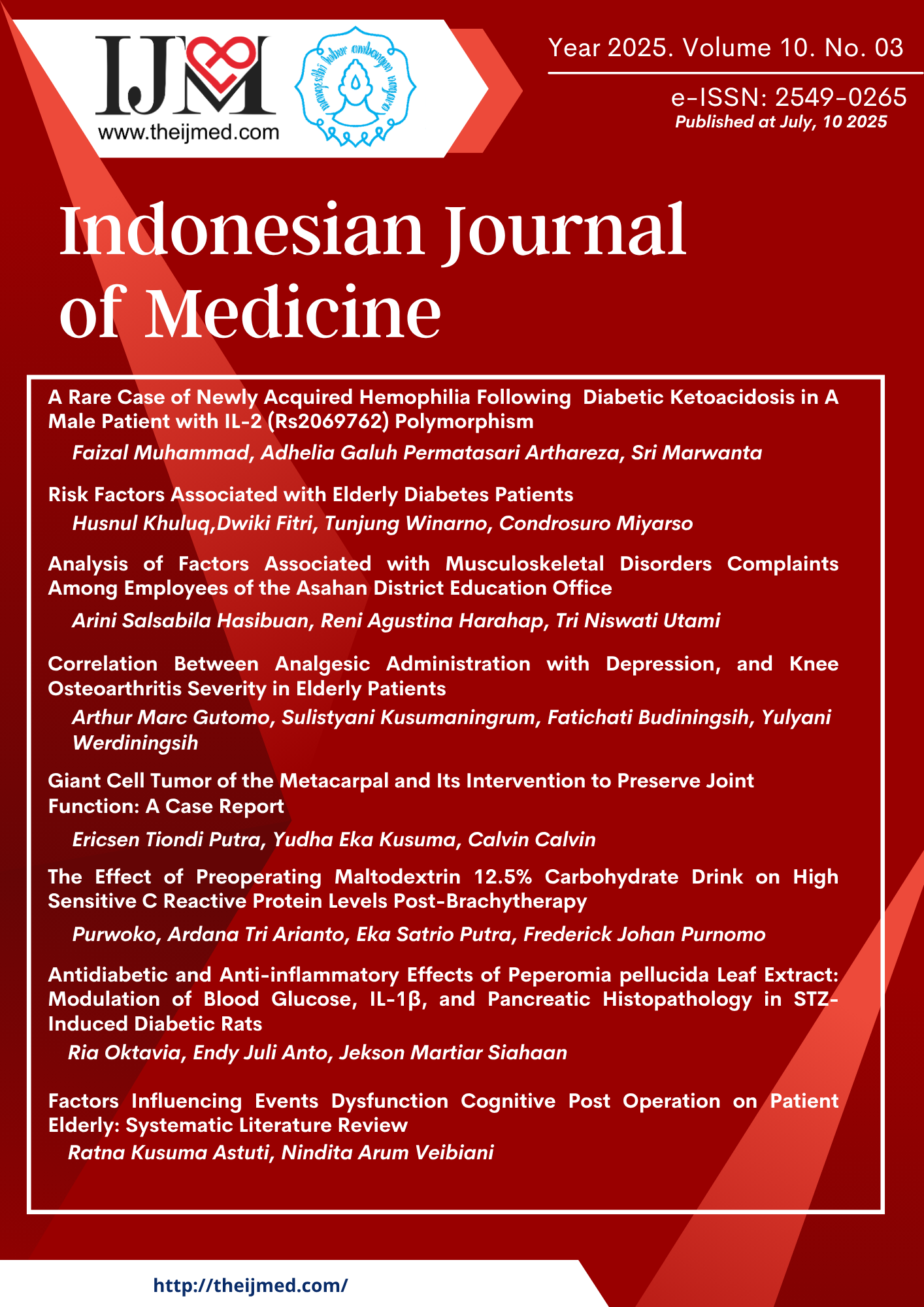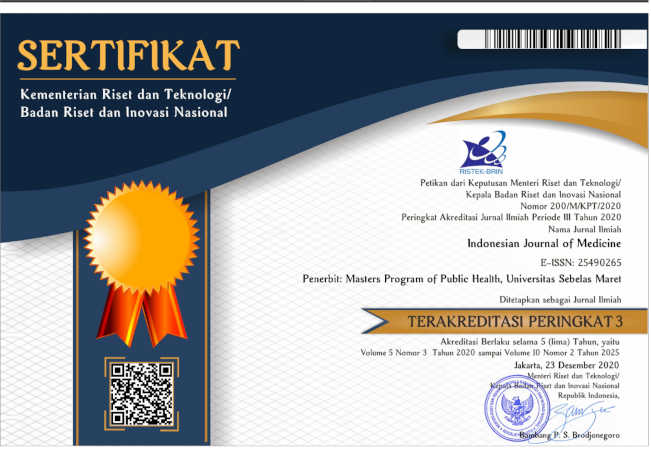A Rare Case of Newly Acquired Hemophilia Following Diabetic Ketoacidosis in A Male Patient with IL-2 (Rs2069762) Polymorphism
DOI:
https://doi.org/10.26911/theijmed.2025.10.3.832Abstract
Background: Diabetes is commonly linked to autoimmune processes, but acquired hemophilia A (AH)—a rare bleeding disorder due to factor VIII (FVIII) inhibitors—remains uncommon, particularly during diabetic ketoacidosis (DKA). Recent studies have suggested a role of IL-2 (rs2069762) polymorphism in FVIII inhibitor development. This study aims to highlight a rare case of newly acquired hemophilia coinciding with DKA and the presence of IL-2 gene polymorphism.
Case Presentation: A 40-year-old male presented with dyspnea, abdominal pain, and signs of DKA. He had a history of drug-induced rash due to sulfasalazine. Initial management with IV fluids and insulin resolved the metabolic crisis. However, on day two, he developed spontaneous bruising and gross hematuria. Laboratory tests revealed a low FVIII inhibitor titer (1.2 BU) and positive insulin antibodies. Genetic testing showed TT homozygous polymorphism of IL-2 (rs2069762), potentially contributing to FVIII inhibitor formation.
Results: The patient was treated with low-dose cyclophosphamide and methylprednisolone, followed by rituximab due to poor initial response. Intensive insulin therapy was also administered. After five weeks, clinical remission of AH was achieved, although the patient remains at risk for relapse due to the IL-2 polymorphism.
Conclusion: This case illustrates a rare interplay between DKA and acquired hemophilia, potentially mediated by IL-2 (rs2069762) polymorphism. Prompt diagnosis and individualized immunosuppressive therapy are essential. The findings support further investigation into genetic predispositions in AH pathogenesis during autoimmune or metabolic stress events like DKA.
Keywords:
Diabetes, hemophilia, hemorrhagic, autoimmune, polymorphism, geneReferences
Cruz MS, Ribeiro E, Oliveira S, Gomes L, Carvalho F, Brito M (2021). Personalised prophylaxis in a child with haemophilia A and type 1 diabetes. Clin Pract. 11(2): 287–292. Doi: 10.3390/clinpract11020041
Dorman JS, LaPorte RE, Stone RA, Trucco M, Kuller LH (2008). Type 1 diabetes and HLA-DR3/4: imply-cations for disease risk and pathogenesis. JAMA. 292(6): 734–73
Eskdale J, Kube D, Tesch H, Gallagher G (1998). Mapping of the human IL10 gene and further characterization of the 5′ flanking sequence. Immuno-genetics. 47(2): 120–128. Doi: 10.1007/s002510050345
Gimenez-Perez G, Puig-Domingo M, Mauricio D (2022). Comorbid auto-immune diseases and burden of diabetes-related complications in patients with type 1 diabetes from a Mediterranean area. Diabetes Res Clin Pract. 191: 110031. Doi: 10.10-16/j.diabres.2022.110031
Gregori S, Goudy KS, Roncarolo MG (2010). The cellular and molecular mechanisms of immuno-regulation by regulatory T cells. J Immunol. 185(4): 1991–1997. Doi: 10.4049/-jimmunol.0901642
Huth-Kühne A, Baudo F, Collins P, Ingerslev J, Kessler CM, Lévesque H, Hay C (2009). International recommendations on the diagnosis and treatment of patients with acquired hemophilia A. Haemato-logica. 94(4): 566–575. Doi: 10.33-24/haematol.2008.001743
Kessler CM (2015). Acquired inhibitors to clotting factors. Hematol Oncol Clin North Am. 29(3): 525–536. Doi: 10.1016/j.hoc.2015.01.003
Kitabchi AE, Umpierrez GE, Murphy MB, Barrett EJ (2009). Hyperglycemic crises in adult patients with dia-betes. Diabetes Care. 32(7): 1335–1343. Doi: 10.2337/dc09-9032
Knoebl P, Marco P, Baudo F, Collins P, Huth-Kühne A, Lévesque H, Hay C (2012). Demographic and clinical data in acquired hemophilia A: results from the European Acquired Haemophilia Registry (EACH2). J Thromb Haemost. 10(4): 622–631. Doi: 10.1111/j.1538-7836.2012.046-54.x
Liu R, Wang X, Liu Y, Zhang X, Wang J, Zhang L (2022). The impact of diabetes on vascular disease: pro-gress from the perspective of epid-emics and treatments. J Diabetes Res. 2022: 1531289. Doi: 10.1155/-2022/1531289
Malek TR (2008). The biology of interleukin-2. Annu Rev Immunol. 26: 453–479. Doi: 10.1146/annu-rev.immunol.26.021607.090357
Marwanta S, Harahap WA, Halim R, Daeng M (2021). The effects of low-dose methylprednisolone as adjuvant therapy for hemophilia A patients with factor VIII inhibitors. J Appl Pharm Sci. 11(12): 196–199. Doi: 10.7324/JAPS.2021.1101219
Marwanta S, Halim R, Siregar GA, Daeng M (2023). Association between interleukin-2 (rs2069762) gene polymorphism and FVIII inhibitor development in Indonesian patients with severe hemophilia A. Med J Indones. 31(4): 213–217. Doi: 10.13181/mji.oa.236439
Nyenwe EA, Kitabchi AE, Umpierrez GE (2015). Diabetic ketoacidosis. In: Kahn CR, Weir GC, editors. Joslin’s Diabetes Mellitus. 14th ed. Philadelphia: Lippincott Williams & Wilkins.
Popoviciu MS, Marcu A, Mihaila R, Gheorghita E, Mihai C (2023). Type 1 diabetes mellitus and autoimmune diseases: a critical review of the association and the application of personalized medicine. J Pers Med. 13(3): 422. Doi: 10.3390/jpm-13030422
Sarmiento Doncel S, Díaz L, López G, Torres A, Velásquez C (2023). Haemophilia A: a review of clinical manifestations, treatment, muta-tions, and the development of inhibitors. Hematol Rep. 15(1): 130–150. Doi: 10.3390/hematolrep-15010014
Sugandh F, Prasad A, Sharma A, Jain P, Kumar S (2023). Advances in the management of diabetes mellitus: a focus on personalized medicine. Cureus. 15(12): e43697. Doi: 10.77-59/cureus.43697
Tang Q, Henriksen KJ, Bi M, Finger EB, Szot G, Ye J, Bluestone JA (2012). In vitro-expanded antigen-specific regulatory T cells suppress auto-immune diabetes. J Exp Med. 199(11): 1455–1465. Doi: 10.1084/-jem.20030358
Tiede A, Klamroth R, Scharf RE, Kisro J, Miesbach W, Goldmann G (2011). Immune tolerance induction in patients with acquired hemophilia A: a multicenter study. Blood. 117(5): 1791–1795. Doi: 10.1182/-blood-2010-07-298182
Umpierrez GE, Kitabchi AE, Murphy MB (2002). Diabetic ketoacidosis in obese African-Americans. Diabetes Care. 25(9): 1556–1562. Doi: 10.23-37/diacare.25.9.1556
Wang CJ, Tang SR, Yang L, Wu B, Li YJ (2011). The polymorphisms of the IL-2 gene are associated with susceptibility to systemic lupus erythematosus in a Chinese population. Int J Immunogenet. 38(1): 15–21. Doi: 10.1111/j.1744-313X.2010.00966.x
Zanon E (2023). Acquired hemophilia A: an update on the etiopathogenesis, diagnosis, and treatment. Diag-nostics. 13(3): 420. Doi: 10.3390/-diagnostics130











